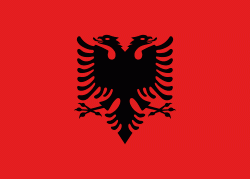Selcë e Poshtme (Selca e Poshtme)
Selcë e Poshtme ("Lower Selcë") is a village located in the Mokra area, Korçë County, Albania. At the 2015 local government reform it became part of the municipality Pogradec. Near the village, on the right bank of Shkumbin river at an elevation of 1040 m above sea level, 5 Illyrian Royal Tombs of Selca e Poshtme are found. In 1996, Albania included the Royal Tombs of Lower Selcë in the UNESCO World heritage list of proposals.
At Selcë e Poshtme an Illyrian settlement was established since the early Iron Age. At the beginning of the 4th century BC the first pre-urban phase evolved into a second urban phase that lasted until the 1st century AD. It was located in the region of the Illyrian Dassaretii. The Illyrian Royal Tombs were built on this site during the 4th and 2nd centuries BC.
The third and last phase of the site was less developed than the two previous phases. Archaeological remains of the first three centuries of the Common Era are the least representative of the site. The settlement continued being inhabited during the Roman Imperial period under Anastasius I and Justinian. The third phase lasted until the settlement was abandoned in late antiquity between the 4th and 6th centuries CE.
The site of Selcë was in antiquity a flourishing economical centre more developed than the surroundings because it occupied a predominant position inside the region currently called Mokër, and because it controlled the road which led from the Adriatic coasts of Illyria to Macedonia.
Lower Selcë is a suggested location of the historic site of Pellion, where in 335 BC Alexander the Great advanced his forces to attack the Illyrians under Cleitus, son of Bardylis and Glaukias of the Taulantii, following the death of Philip II, thus securing Macedonia's northern border before leaving to conquer Asia. However alternative locations for Pelion have been proposed, including Zvezde near Korça or in Goricë. In the area of modern Pogradec, Illyrians seems to have been influenced by the styles of the Macedonians.
At Selcë e Poshtme an Illyrian settlement was established since the early Iron Age. At the beginning of the 4th century BC the first pre-urban phase evolved into a second urban phase that lasted until the 1st century AD. It was located in the region of the Illyrian Dassaretii. The Illyrian Royal Tombs were built on this site during the 4th and 2nd centuries BC.
The third and last phase of the site was less developed than the two previous phases. Archaeological remains of the first three centuries of the Common Era are the least representative of the site. The settlement continued being inhabited during the Roman Imperial period under Anastasius I and Justinian. The third phase lasted until the settlement was abandoned in late antiquity between the 4th and 6th centuries CE.
The site of Selcë was in antiquity a flourishing economical centre more developed than the surroundings because it occupied a predominant position inside the region currently called Mokër, and because it controlled the road which led from the Adriatic coasts of Illyria to Macedonia.
Lower Selcë is a suggested location of the historic site of Pellion, where in 335 BC Alexander the Great advanced his forces to attack the Illyrians under Cleitus, son of Bardylis and Glaukias of the Taulantii, following the death of Philip II, thus securing Macedonia's northern border before leaving to conquer Asia. However alternative locations for Pelion have been proposed, including Zvezde near Korça or in Goricë. In the area of modern Pogradec, Illyrians seems to have been influenced by the styles of the Macedonians.
Map - Selcë e Poshtme (Selca e Poshtme)
Map
Country - Albania
 |
 |
| Flag of Albania | |
Albania has been inhabited by different civilisations over time, such as the Illyrians, Thracians, Ancient Greeks, Romans, Byzantines, Venetians, and Ottomans. The Albanians established the autonomous Principality of Arbër in the 12th century. The Kingdom of Albania and Principality of Albania formed between the 13th and 14th centuries. Prior to the Ottoman conquest of Albania in the 15th century, the Albanian resistance to Ottoman expansion into Europe led by Skanderbeg won them acclaim over most of Europe. Albania remained under Ottoman rule for nearly five centuries, during which many Albanians (known as Arnauts) attained high-ranking offices in the empire, especially in the Southern Balkans and Egypt. Between the 18th and 19th centuries, cultural developments, widely attributed to Albanians having gathered both spiritual and intellectual strength, conclusively led to the Albanian Renaissance. After the defeat of the Ottomans in the Balkan Wars, the modern nation state of Albania declared independence in 1912. In the 20th century, the Kingdom of Albania was invaded by Italy, which formed Greater Albania before becoming a protectorate of Nazi Germany. Enver Hoxha formed the People's Socialist Republic of Albania after World War II, modeled under the terms of Hoxhaism. The Revolutions of 1991 concluded the fall of communism in Albania and eventually the establishment of the current Republic of Albania.
Currency / Language
| ISO | Currency | Symbol | Significant figures |
|---|---|---|---|
| ALL | Albanian lek | L | 2 |
| ISO | Language |
|---|---|
| SQ | Albanian language |
| EL | Greek language |















